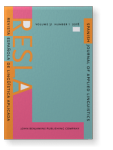Vol. 31:1 (2018) ► pp.224–256
Vol. 31:1 (2018) ► pp.224–256
Analyzing the relationship and development of proficiency, derivational knowledge, and vocabulary size in Spanish L2 learners
One dimension of knowing a word is recognizing its structure. Previous research, mostly on L2 English, has revealed a close link between derivational knowledge (DK) and vocabulary size. Nevertheless, the degree of the relationship as well as the effect of the learner’s L1 vary among these studies. The present study analyzes the development of DK in L1 English learners of L2 Spanish (n = 209) taking university level courses from second to seventh semester at a US institution. The measurements explore the complex nature of DK – i.e., relational, syntactic and distributional knowledge – in both receptive and productive mode. Results showed that proficiency rather than vocabulary size, i.e., knowledge of monomorphemic words, contributes to DK. While a full receptive knowledge of some suffixes can be acquired relatively early, this is not the case for productive knowledge. This study also provides some tools to measure DK without resorting to metalanguage.
Article outline
- 1.Introduction
- 1.1Depth and breadth constructs
- 1.2The relationship between vocabulary size and Derivational Knowledge (DK) in foreign language learners
- 1.3Testing of vocabulary size and Derivational Knowledge (DK)
- 2.Study
- 2.1Research questions
- 2.2Participants
- 2.3Materials, design and procedure
- 2.3.1Proficiency Test
- 2.3.2Vocabulary Size Test
- 2.3.3Test of Word Families
- 2.3.4Test of Productive Knowledge
- 2.3.5Test of Receptive Knowledge
- 3.Results
- 3.1Effect of learners’ proficiency level on vocabulary and Derivational Knowledge (DK)
- 3.1.1Effect of learners’ proficiency level on vocabulary size
- 3.1.2Effect of learners’ proficiency level on derived words
- 3.1.3Effect of learners’ proficiency level on productive Derivational Knowledge
- 3.1.4Effect of learners’ proficiency level on receptive Derivational Knowledge
- 3.2Predicting Derivational Knowledge
- 3.2.1Predicting productive Derivational Knowledge
- 3.2.2Predicting receptive Derivational Knowledge
- 3.1Effect of learners’ proficiency level on vocabulary and Derivational Knowledge (DK)
- 4.Discussion
- 5.Conclusion
- Acknowledgements
- Notes
-
References -
Key Publications
